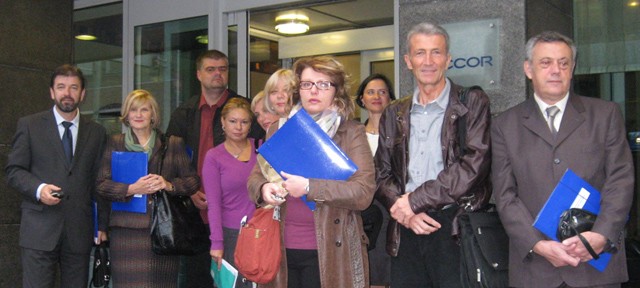
Serbian judicial reforms of 2010 and 2013 have had a dramatic effect on the work of the courts, and have brought with them a vital need for a court administrator to help manage these transitions. The 2010 reforms merged many courts, bringing significant changes to the daily lives of court employees and court users.
With 138 municipal courts becoming 34 basic courts, caseloads changed for judges—many of whom did not return to their posts. The roles of court buildings also changed significantly, with office space and facilities adapting to new circumstances and requirements.
In 2014, only four years after the initial reduction in court numbers, the 34 basic courts will grow in numbers—this time into 60 courts.
USAID's Separation of Powers Program helped to create the post of “court manager” or “court administrator" in the Serbian court system to manage operational and daily activities of the courts. The first court manager was appointed in 2010. In November 2013, the newly adopted Law on Court Organization codified the duties and responsibilities of the position.
USAID trained seven administrators working in some of the biggest courts in the country, including the higher misdemeanor court, the appellate court in Novi Sad, the higher and misdemeanor courts in Belgrade, the higher and commercial courts in Nis, and the basic court in Novi Sad.
The court administrator is the highest non-judicial position in the court system, responsible for managing finances and administration. Working together, the court administrator, court president and court secretary form a practical and operative trio that manages the court more efficiently.
“After establishing an annual financial plan, my most important monthly, even daily, activity is implementation of the plan, which funds were secured, when and how they were spent,” explained Dragana Djukic, administrator at the appellate court in Novi Sad. “Besides handling of the finances, I spend most of my time working with the staff, consulting the heads of different departments, reporting to the acting court president, managing the building. I do not do one job only, but three or four at the same time,” she added.
A good example of this important new management role is the administrator at the basic court in Novi Sad, Zorica Stajic, who is heavily involved in the court’s finances as well as maintenance of the facilities.
“Since we are a basic court with 10 court units and 625 employees without the head of accounting department, my activities are mainly focused on finances and organization," said Stajic. "This means making the financial plan and harmonizing it with appropriations, supervising procurement, payments, reporting, organizing the training of staff, and maintenance of court units.”
As more courts begin to hire administrators, USAID will provide them technical assistance. Together with the Judicial Academy, USAID developed training modules on court administration for administrators and presidents. The training sessions, now a regular offering of the Judicial Academy, give the courts’ top officials effective techniques to manage and organize the work of the court.
“Trainings I attended meant a great deal for several reasons. First, the bond between us, the administrators, from different courts grew stronger. Every problem or task is resolved easier if we share ideas, information, best practices. Second, each course taught us something new, added to our confidence, gave us guidelines or ideas,” said Djukic.
The new law prescribes that the administrator should be employed at the highest instance courts, appellate courts or courts with 30 judges or more, and if several courts are sharing the same building and facilities. Stajic explained that the Law on Court Organization regulates the post of a court administrator and the relationship he or she has with the court president, court secretary and the rest of the staff. It also provides more security for the administrator.
The new law is also “determining further policies for the development of administration within the Serbian judiciary,” added Djukic.
To make the administration of justice more efficient and responsive, USAID will continue to work with the current administrators as well as to provide mentoring to those newly appointed. The Judicial Academy is also continuing to train new administrators to make their jobs more effective and provide benefits to citizens and court staff in their daily work and activities.
The five-year Separation of Powers Program was launched in 2008 to help Serbia move closer to European Union accession by strengthening the judicial and legislative branches of government.







Comment
Make a general inquiry or suggest an improvement.